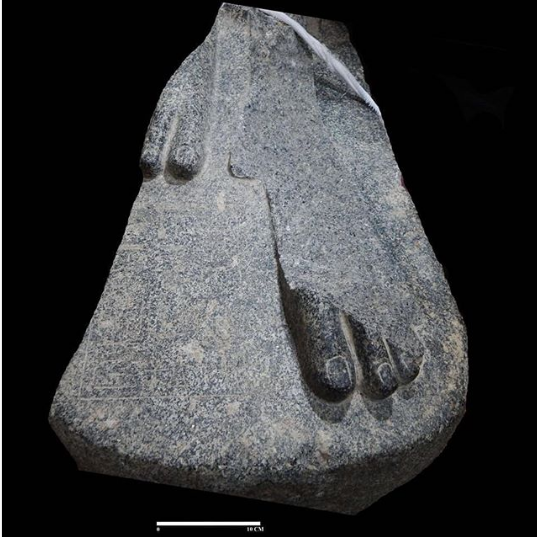Granite feet discovered in Egyptian parking lot traced back to ancient statue of King Amenhotep III
The stone fragment includes hieroglyphics that detail the pharaoh's birth name and coronation.

An Egyptian construction crew at the site of a parking lot, which was undergoing development, has discovered an ancient artefact from the time of the pharaohs. The Ministry of Antiquities confirmed that a part of a statute of King Amenhotep III has been found in the city of Akhmim, in the Sohag governorate.
According to a statement released by the ministry on 8 January, the fragment would have made up part of the base of a black granite statue of the pharaoh. It comprises his left foot and part of the right one and includes hieroglyphic writings about the coronation and birth of Amenhotep III.
As was typically portrayed of the rulers of ancient Egypt, the left foot is presented forward.
The Antiquities Committee, headed by Gamal Abdel Nasser, the general manager of Sohag antiquities sector confirmed that the piece was a historical artefact but is yet to determine its age and where the rest of the statue is. It has been transferred to the Sohag Museum for further study and restoration.
Egypt Today reported that based on discoveries made to date, Amenhotep III, the 9th Pharaoh of the 18th Dynasty, has the largest number of statues of any ruler of the time, 250 in total.
Born in 1388 BC, he ascended the throne at a very early age — possibly between 6 and 12 years. At the time, Egypt was flourishing as a centre for business, politics and art. Much of the ruler's life and career have been documented in the Amarna Letters — a collection of cuneiform-inscribed clay tablets.
Unlike most of his predecessors, Amenhotep III was a man of diplomacy. At the time, Egypt was extremely wealthy, and in order to protect his kingdom, the pharaoh decided to share some of it, but only enough to keep his potential rivals on good terms. According to the Amarna Letters, the king offered gifts of gold in return for their allegiance.
However, PBS reports that he was not as generous with suitors. A number of foreign princes vied for the hand of an Egyptian princess in order to cement their ties to the royal family but Amenhotep chose to keep his bloodlines pure and reduce chances of his empire falling into the hands of an outsider.
He ruled for 38 years, marrying Tiye, a commoner with whom he had two sons, Crown Prince Thutmose and Amenhotep IV.
Following his death, the king was buried in the Western Valley of the Kings.






















